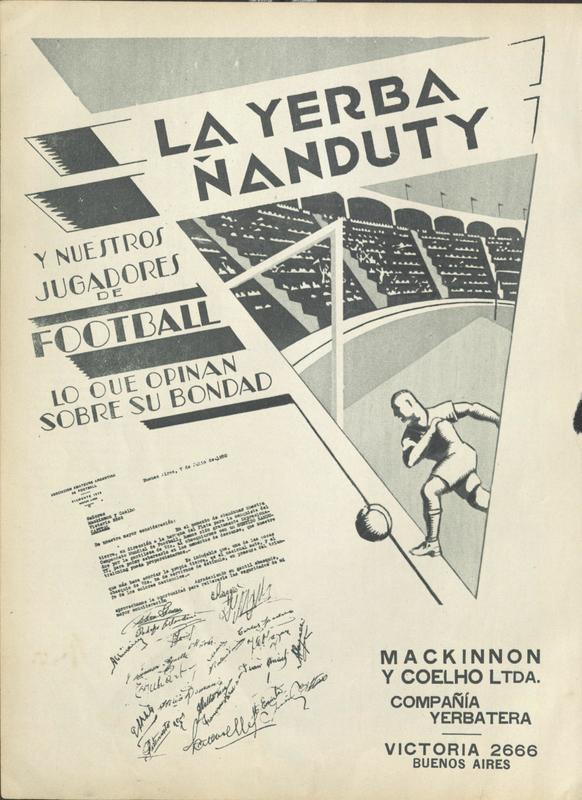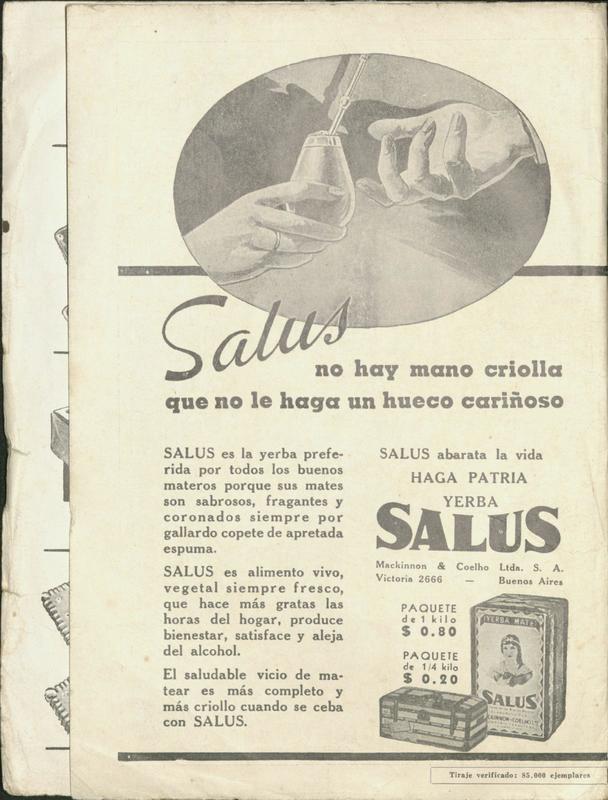Argentine Yerba Mate Advertisements of the 1930s
Going up against Paraguayan-produced yerba, Argentine yerba mate brands of the 1930s had to create effective advertising to assert and grow their market power within such a competitive environment. During this time, Argentina's yerba mate industry was expanding, with the country becoming the world's leading producer of the commodity, surpassing its competitors Brazil and Paraguay (Folch, 16). Yet, despite being the leading producer of yerba mate on the national level, Argentine yerba producers still had their work cut out for them as Paraguayan yerba was widely regarded as being of higher quality than Argentine yerba (Folch, 16).
As I outlined in more detail previously, Argentina and Paraguay have had a long, tumultuous history that, in the early 20th century, included race and ethnic dynamics. While Paraguay generally acknowledged and at various times even promoted its own indigenous, Guaraní national heritage and identity, Argentina's national self-image by the 1930s had mostly cleansed the presence of indigenous cultures from within Argentine identity, with a new image of Argentina as a whiter "nation of immigrants," with the idealized Argentine "nation" comprising primarily of European immigrants and those descended from European immigrants (Kaminsky, 104). It was within this context that, in order to compete with the Paraguayan brands, many Argentine yerba companies decided to appeal to Argentine nationalism in their advertising, also portraying themselves as being affordable and available to the Argentine everyman, creating a stark contrast with the Parguayan advertisements that focused primarly on their products' high quality.
This image on the right was produced by the Argentina-based Mackinnon & Coelho company in 1930, targeting Argentine consumers with its yerba "Ñanduty."
The primary aim of this advertisement is to encourage sales by promoting and featuring language and symbols of Argentine national identity and unity. In this specific advertisement, the advertisers utilized the national football (soccer) team as a nationally-unifying symbol. At this time, Argentina's football team was a source of great national pride. Though it is unclear exactly when this advertisement was created and published, it probably ran throughout July 1930, the month of the first-ever World Cup, and the months afterwards. This was a period of great success for the Argentine football team, competing in the World Cup and making it all the way to the first-ever World Cup Final, finishing runners-up to Uruguay. The team was well-known and widely popular throughout Argentina, representing the nation very well on the international stage. Featuring them in this advertisement would have granted the yerba itself at least some of the sense of national legitimacy and authority that was associated with the football team, making the product more appealing and attractive in a congested yerba market.
The ties between the advertised yerba, the Argentine national football team, and the Argentine nation itself are further strengthened within this advertisement through the featured letter, penned and signed by the members of the team themselves on July 7, 1930, the eve of their departure for the World Cup. The letter itself speaks of their leaving to compete in the World Cup, making many references to the Argentine nation, speaking of "nuestra tierra" and "los colores nacionales," "our land [of Argentina]" and "the national colors," referring to the Argentine football uniform that featured the national colors (blue and white). The footballers even went so far as to describe Mackinnon & Coelho's yerba "ñanduty" as "el nacional mate," the national yerba mate. There is no doubt here: the yerba mate was proclaimed to be Argentina's national mate, of the nation and for the nation, by these footballers, well-liked portraits of the idealized Argentine citizen who went as far as to sign their approval of the yerba mate.
From a marketing standpoint, this advertisement probably would have been pure gold. It effectively instilled and evoked national pride with well-known backers lending it the authority to truly represent the nation. This advertisement was strong enough to appeal to the consumer based solely on national identity. No Paraguayan brand could create an advertisement that would appeal to Argentine consumers in this way. While Paraguayan advertisers would have emphasized their products' quality or associations with upper-class Argentine society, this Argentine advertisement features little of those approaches. This product's selling point is based almost entirely on its Argentine legitimacy and national association rather than its quality or anything else.
Other Argentine advertisements from the 1930s also looked to invoke national imagery and wording in relation to their yerba mate products. For example, this image on the left is an advertisement for Salus brand yerba mate created in 1939 by the Mackinnon & Coelho company to market their product towards Argentine consumers with such a strategy.
In this advertisement, the primary selling points are the yerba mate's status as "criollo" and the listed prices. With the use of the word criollo multiple times, the advertisement appeals to Argentine consumers and invokes a sense of Argentine nationality. The description of the yerba as being "más criollo" or being the most criollo of all yerbas, meaning that it is local as well as inherently and completely Argentinian also feeds into this national appeal. The advertisers were aiming to establish Salus as an Argentine product, directly related to the "patria," or motherland, of Argentina.
While some Paraguayan advertisements tried to pass themselves as being traditional within Argentina and in Argentine culture, they often did so through associating themselves with the Argentine upper class. While this strategy was logical for the higher quality Paraguayan yerba brands, Argentine advertisements like this one are seemingly aimed at the whole of the Argentine populace, lacking the class symbols present in Paraguayan ads and instead prominently featuring the price of the product.
Through emphasizing the affordability of their product, brands like Salus looked to appeal to the Argentine nation as a domestic product that was cheaper than some of the higher quality Paraguayan products, thus being able to be enjoyed by all Argentine citizens, regardless of class or economic status. The Paraguayan brands were aiming at the whole Argentine population through the depictions of class symbols and high class Argentines, hoping to create desire throughout Argentine society for this high quality product whereas the strategy behind this Salus ad probably would have been more all-encompassing, pursuing widescale sales and popularity so that there would not be a "mano criolla" (criollo hand) without a mate of Salus yerba. This widespread appeal also serves as a tacit rejection of the foreign, more expensive yerba peddled by Paraguayans which might not have been available or pracitcal for all Argentines. Salus, on the other hand, is an Argentine product that will unite Argentines.
As exemplified by both of these images, Argentine advertisers portrayed yerba mate as a purely Argentine commodity and cultural institution. Argentine yerba mate companies did not address yerba mate in the context of any other nations, nor did they acknowledge the indigenous history of yerba mate. Instead of portraying the history and heritage of yerba mate, most Argentine yerba mate advertisements chose to focus on Argentine national symbols and yerba mate's status within the contemporary Argentine historical moment.


